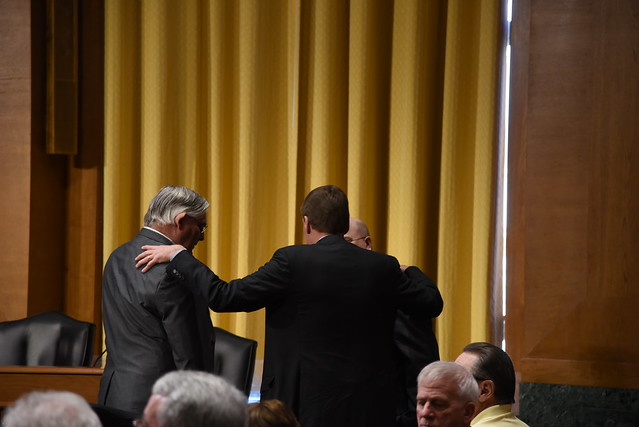Press Releases
Warner, Kaine, Manchin Push to Equip Mine Rescuers with State-of-the-Art Communications Technology
Senators support $6 million in funding for wireless mine safety communications and tracking systems
Mar 22 2016

Sen. Warner meets with two retired Virginia coal miners at the U.S. Capitol
WASHINGTON – U.S. Sens. Mark R. Warner (D-VA), Tim Kaine (D-VA) and Joe Manchin (D-WV) have called for $6 million in funding to fully equip all U.S. Mine Safety and Health Administration (MSHA) mine rescue teams with state-of-the-art, next-generation mine rescue communications equipment that allows rescuers to respond quickly in the event of an underground emergency.
“Traditional communications systems used during mine rescue are tedious, slow and ineffective, and require running spools of cable with page phones or radios. Running cumbersome communications cable to coordinate mine rescue operations delays the mine rescue mission and unnecessarily puts rescuers at risk,” wrote the Senators in a letter to leaders of the Appropriations Committee. “In comparison, the deployment of wireless technology is more effective and reliable, which makes a significant difference when mine rescue teams have a short window of time in which to perform.”
MSHA currently has several field offices with federal mine rescue capabilities, including in Beckley, West Virginia, but only two of MSHA’s locations in Pittsburgh and in Denver have fully equipped wireless mine safety communications and tracking systems that can significantly reduce response time after mining accidents.
Noted the Senators, “Rescue operations, which once took days, now can be completed in hours if equipment and teams are readily available.”
But as it stands, the equipment allocation could require long transport times if support is needed following an underground mining accident. In a letter to the leaders of the Senate Appropriations Committee, Sens. Warner, Kaine and Manchin urged appropriators to include $6 million in funding to fully equip all MSHA mine rescue teams with next-generation mine rescue communications equipment.
The full text of the letter is below. A PDF of the signed letter is available here.
Dear Chairman Cochran, Ranking Member Mikulski, Chairman Blunt, and Ranking Member Murray:
We are writing to urge the Committee on Appropriations and the Subcommittee on Labor, Health and Human Services, Education, and Related Agencies to provide $6 million in Fiscal Year 2017 funding to fully equip all U.S. Mine Safety and Health Administration (MSHA) mine rescue teams with next generation mine rescue communications equipment.
MSHA currently has several field offices with federal mine rescue capabilities including: Price, Utah; Pittsburgh, Pennsylvania; Denver, Colorado; Beckley, West Virginia; and Madisonville, Kentucky. Currently, MSHA only has fully equipped communication and tracking systems in Pittsburgh and Denver. The current MSHA response plan and equipment allocation potentially requires long transport times staged from these two locations when supporting any underground mining accident.
Since the passage of the Mine Improvement and New Emergency Response (MINER) Act in 2006, wireless mine safety communications and tracking technology has made every day mining operations significantly safer and more efficient. However, until recently these technological advances have not been available to mine rescue first responders.
The need for rapidly deployable, lightweight and rugged communication and tracking systems, including atmospheric sensors, to support mine rescue first responders, is of high priority to the over 300 mine rescue teams (federal, state and private) in the U.S. This technology has been proven in actual deployments across the country over the past several years. Recent examples include supporting a Colorado gold mine recovery operation, a salt mine fire in Texas, and a coal mine accident in Indiana. Rescue operations, which once took days, now can be completed in hours if equipment and teams are readily available.
Traditional communications systems used during mine rescue are tedious, slow and ineffective, and require running spools of cable with page phones or radios. Running cumbersome communications cable to coordinate mine rescue operations delays the mine rescue mission and unnecessarily puts rescuers at risk. In comparison, the deployment of wireless technology is more effective and reliable, which makes a significant difference when mine rescue teams have a short window of time in which to perform. For the past several years, MSHA has worked with industry to develop next generation wireless mine rescue communication capabilities for federal mine rescue teams, to significantly reduce response time after mining accidents.
Accordingly, please include $6 million in the Fiscal Year 2017 Labor, Health and Human Services, Education, and Related Agencies Appropriations Act in order to fully equip all MSHA mine rescue teams with next generation mine rescue communications equipment and provide the critical support our nation’s mine rescue teams deserve.
Sincerely,